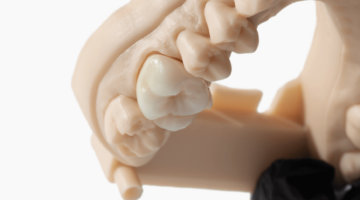If you own, operate, or partner in a dental practice, you’re responsible for both the health of your patients and business. In dentistry, as in any other industry, success means growth. But you didn’t go to business school–how are you supposed to know what exactly constitutes practice growth, let alone how to facilitate it?
KPIs or Key Performance Indicators are metrics indicating how effective a business or organization is at achieving its goals. KPIs help to paint a picture of both the business’s overall health and the role of its discrete components, giving the owner or executive a concrete basis for developing ongoing strategy. KPIs may be different depending on a business’s industry, specific objectives, and risks/opportunities. KPIs for dental practices can be tracked and represented visually using a dental KPI dashboard. By identifying and monitoring critical dental practice KPIs, you can begin to mitigate the challenges to growth and jump-start progress toward your goals.
Following, you will find a list of six essential dental practice KPIs that you should apply to your own practice. Whether you have ambitions to expand your customer base, raise brand awareness, enter new markets, diversify your product and/or service offerings, or some combination of these aims–even if you simply want to streamline your business’s overall efficiency, KPIs pave the way forward.
Active patient numbers
The number of patients currently scheduled for an appointment is a vital dental metric that should be front-and-center on your dental KPI dashboard, daily. Analyzing your annual production and collection numbers and dividing them by the number of active patients allows you to calculate the average value for each. Doing so will clarify why dental patient retention is your practice’s bedrock, how damaging each instance of attrition is to your business, and why any patient on your roster without a scheduled appointment represents potential loss.
Considering the cost of acquiring new patients is between $150-$300, it’s important to maximize your existing stable. Ideally, growth would mean that 98% of patients are scheduled at all times, but a practical target of 95% will still yield positive results. You can begin getting on top of this number by:
- Carefully tracking overdue vs. inactive vs. active patients
- Proactively scheduling every patient to prevent inactivity (scheduling a next visit before a patient has left their current appointment)
- Using multiple communication channels for outreach i.e. mailers, emails, texts, phone calls, etc.
After this effort, you can compare the number of patients contacted daily to those who have been reactivated i.e. scheduling and showing up for appointments after a period of dormancy. Closely tracking which methods of contact work best can also help you more efficiently apply resources. You should aim to reactivate 85% of inactive patients. It’s also worth noting that Inactive patients don’t refer friends and family to your practice; doing an outstanding job with a larger number of patients is the thriftiest form of advertisement for your practice.
Case acceptance
Case acceptance is a critical dental metric as it directly impacts production, revenue, collection, and profit. National averages indicate case acceptance rates of 50-60% for established patients and 25-35% for new patients. You want to see those little squiggly lines on your dental KPI dashboard jump by doubling case acceptance rates for new patients and bumping current patients up to 85-90%. That may sound daunting, but luckily most of the tools you need to facilitate meaningful change cost nothing more than concerted effort.
If data shows that 85% of case acceptance was due primarily to patients’ emotional response, it is clear that success of this endeavor goes directly to clear communication, bedside manner, and trust.
Dandy has in-depth strategies for increasing dental case acceptance, but in short, you should aim to:
- Encourage patient involvement in their treatment
- Offer thorough explanations for every step of treatment
- Use simplified language
- Use visual aids (like a wellness scan) to help edify your patients
- Approach every case empathetically
- Motivate your team to prioritize case acceptance
Creating a patient-centric environment is crucial as patient comfort and trust have measurable affects on your bottom-line. Tracking this dental metric using a dental KPI dashboard will promote treatment efficiency by allowing you to work within the constraints of production costs, patients’ budgets, and insurance obligations to maximize opportunity.
It is also well worth noting that data shows case acceptance and overall patient satisfaction is positively correlated with the use of visual aids and adoption of new tech, both. Many dentists have reported the demonstrable effect from the ‘wow’ factor of presenting patients with digital scans and 3D models created with an intraoral scanner. Patients who post before/after scans showing positive results are a smart, free form of advertising, especially if your practice has an account to @ or tag.
Production
Production is widely considered a foundational dental practice KPI, serving as a significant measure of business health in itself but also as a means of measuring other KPIs. Production is defined as the average sum of money a dental office anticipates receiving over a specific period.
Your production KPI for dental practice can be categorized into various subcategories, including production per hygienist, dentist, patient, and within specific date ranges with each providing valuable insights into different aspects of practice performance. These divisions can help you target areas for improvement, but they can also help you with other important analyses, like reducing overhead or calculating revenue.
In addition, different factors such as insurance or practice partnership will make calculating your production different from other practices. Determining, understanding, and improving this dental metric is essential to improving practice growth; there are few other ways to quantify the value of different aspects of your business.
Revenue
While its utility as a KPI is fundamental, there is actually no single definition of revenue. The metric can be defined in different ways to similar effect, for different reasons depending on a number of variables. Some practices find it useful to equate revenue with total aggregate production, while others see revenue as collections or payments received. It may help to think of revenue as essentially all the income your practice earns before deducting expenses. But revenue should not be considered one single number with a single, fixed referent; there are four main sources of dental practice revenue to track on your dental KPI dashboard:
- Customer payments
- Insurance payments
- Interest on liabilities
- Reimbursements
Many factors can significantly impact how revenue plays into your business calculus, especially for the purposes of goal-setting; patient financing, insurance, and how you’ve decided to classify revenue itself all play a role. However you define revenue for your practice, keep two critical considerations in mind: revenue does reflect total income generated by your practice’s primary operations and does not deduct any associated costs or expenses associated with operating the business.
Profit
Tracking profit is, unsurprisingly, a critical KPI to track. Profit or net income or your bottom-line may simply be defined as total income after expenses. Many complex factors will affect your calculation of profit. Consider the old paradoxical but nevertheless accurate chestnut, “You’ve got to spend money to make money.” Sound understanding of exactly which factors influence your bottom line and its overall utility will guide smart decision-making, i.e. investing in new efficiency-boosting tech that pays for itself, raises profit, and increases your practice’s value. Any and every business decision should, at base, aim to improve your bottom line.
Overhead
Overhead is any expense incurred in the course of running your business, and is one of the primary KPIs that must be carefully monitored. In fact, reducing overhead can have a similar positive impact on your business as increasing profit. On your dental KPI dashboard, you should categorize overhead into two types:
Fixed overhead is any expense not subject to change month over month. The ADA suggests aiming to cap fixed overhead at 4–7% of total production. Examples of fixed overhead are:
- Rent
- Staff wages
- Taxes
- Insurance
Variable overhead is any expense that may vary depending on business activity. The ADA’s recommended range is 45-55% of total production. Examples of variable overhead are:
- Office and dental supplies
- Marketing costs
- Shipping and logistical costs
- Lab fees
Fixed overhead is difficult to change, reverse, or reduce, which puts consistent pressure on business performance, especially when you consider that the median dental practice overhead accounts for 75% of collections. Dividing overhead into sub-categories i.e. salaries, equipment, investments, can help you track and control it. An essential practice for reducing overhead is benchmarking, or comparing your monthly or quarterly expenses to previous equal timeframes in order to gain valuable insight.
How to track dental practice KPIs
KPIs for a dental practice are indispensable. Monitoring the health and success of your business aids in strategic decision-making and facilitating growth; a healthy business is good, but a successful one is better. Whether you’re tracking patient activity, case acceptance rates, production, revenue, profit, or overhead, KPIs provide indispensable insight, allowing you to evaluate your practice performance and identify areas for improvement. By utilizing a dental KPIs to visualize these metrics and setting clear targets, you can effectively streamline operations, maximize profitability, and–most importantly–enhance the quality of your patients’ experiences and care.
To learn more, including statistical analysis and insights from expert sources, download Dandy’s KPI e-book today!
Free Dental KPIs Ebook
Want more insight into Dental Practice KPIs and how to measure them?
Six KPIs, Benchmarking, and Ways to Improve Your Practice Health is an eBook that equips practice owners and managers with a reference guide to managing practice performance and improving their literacy on what data matters when tracking practice performance.




